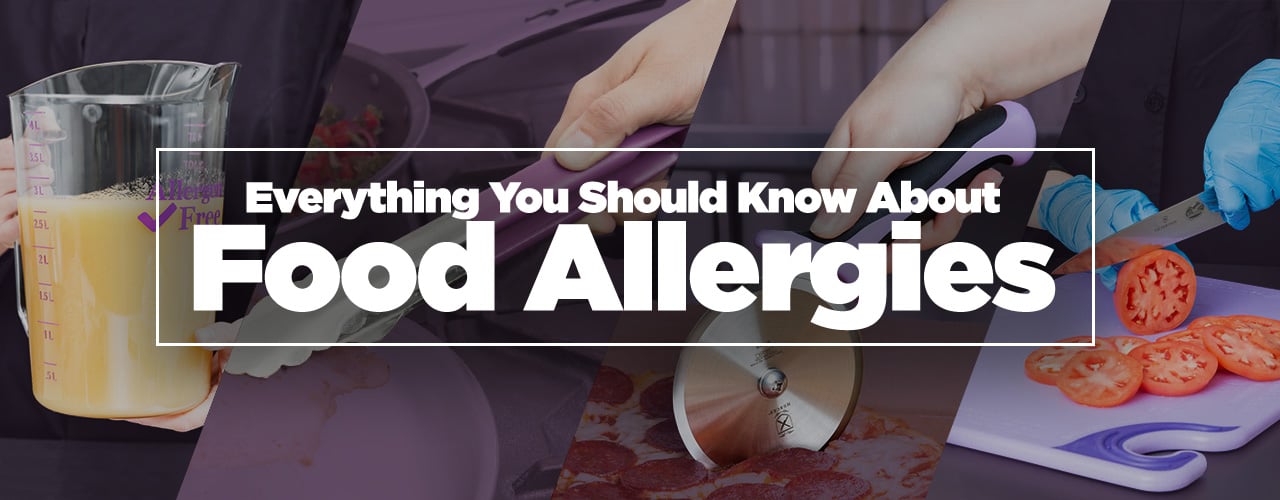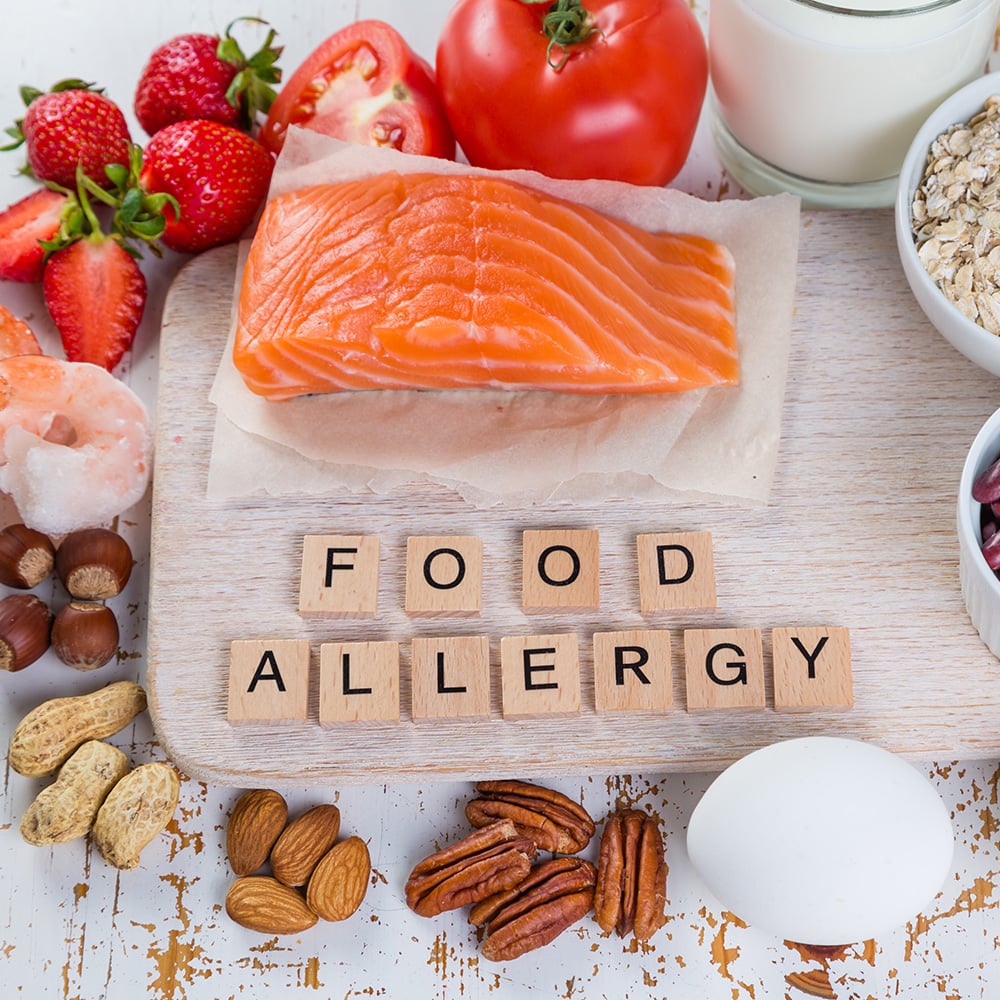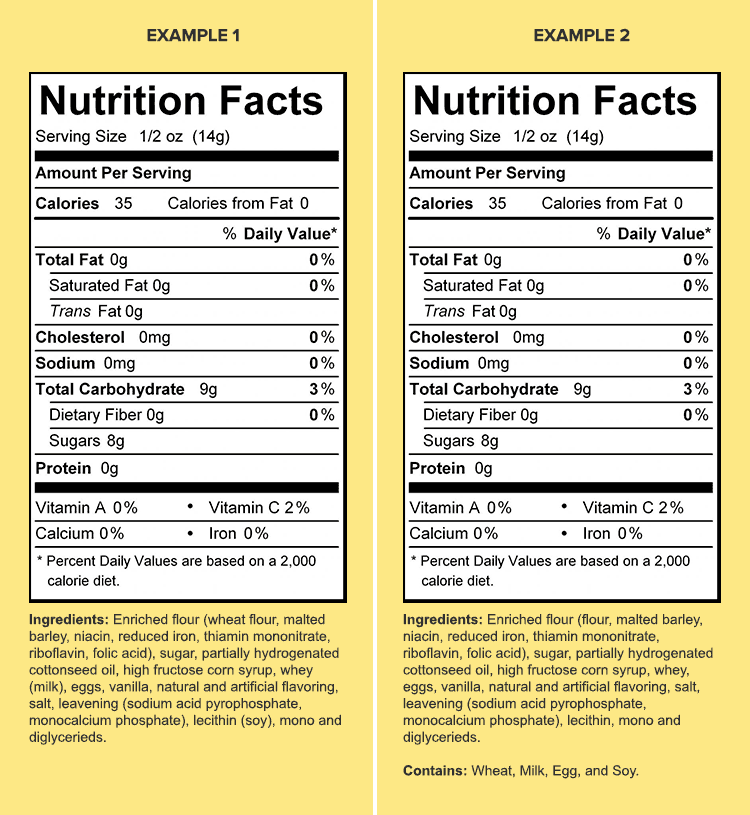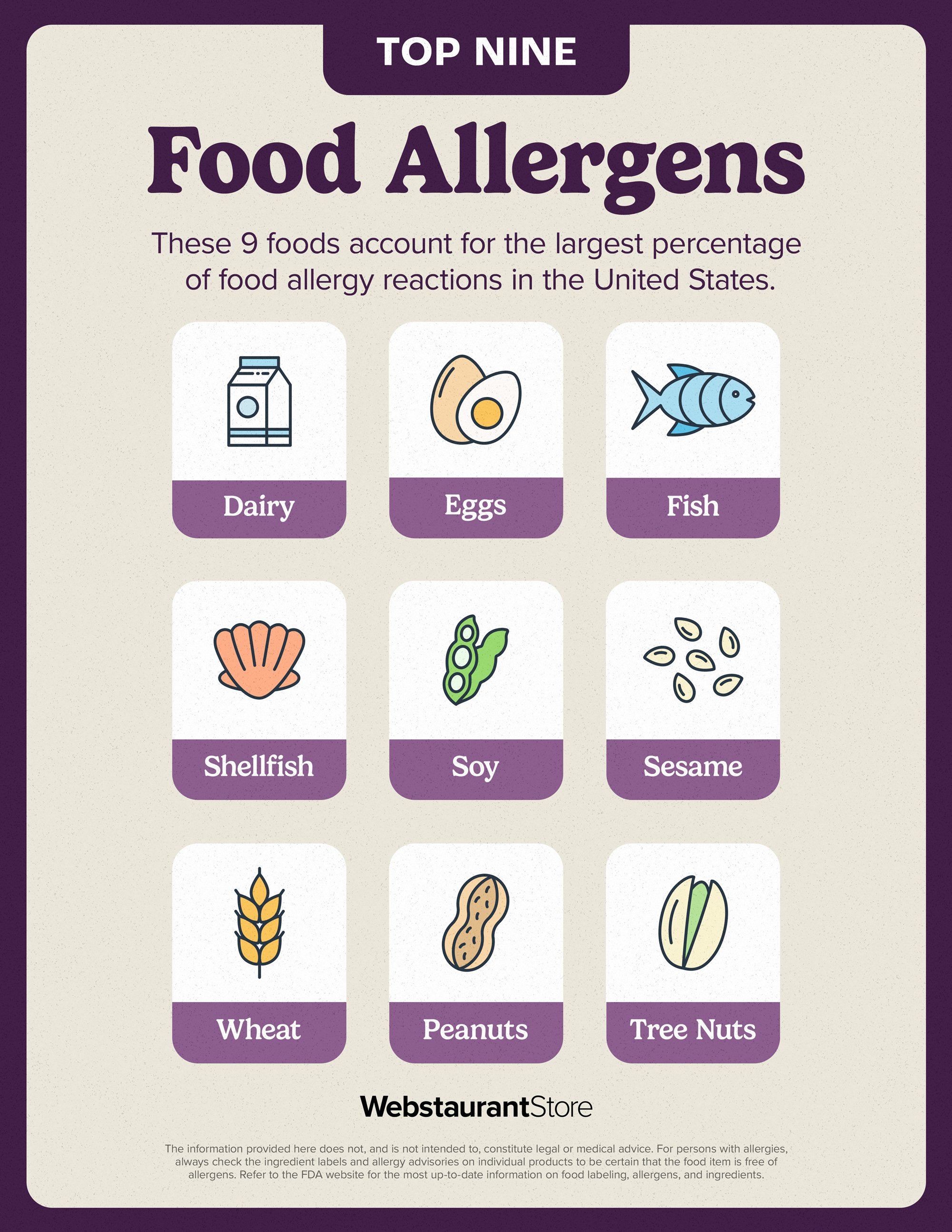
Top Food Allergens List and Safe Food Handling Tips
Last updated on 12/21/2023If you run a food service business or cafeteria, you must educate yourself on common food allergens and how to prevent allergic reactions. According to the CDC, roughly 6.2% of adults and 5.8% of infants and young children in the United States suffer from food allergies. While safely serving patrons with food allergies may seem complicated and risky, there are food safety practices and procedures to implement that can reduce the risk of food allergy reactions. Keep reading to learn more about the major food allergens, allergen labeling, and how to protect your patrons.
Shop All Color-Coded Kitchen Supplies
The Big 9 Allergens
While there are over 160 known sources of food allergens, a small group of allergens known as the "Big Nine" are responsible for a whopping 90% of all food allergy reactions. Consumption of these foods by affected individuals is most likely to result in severe or life-threatening allergic reactions.
1. Dairy Milk
A dairy milk allergy is one of the most common food allergies in infants and young children. Individuals who are allergic to cow's milk should also avoid milk from other domestic animals. If you operate a coffee shop, discover the best non-dairy creamers for coffee.
Common Sources of Dairy Allergens: Buttermilk, cheese, pudding, sour cream
Unexpected Sources of Dairy Allergens: Caramel, chocolate, lunch meat, steaks
2. Eggs
Many people are also allergic to eggs, including young children. The whites of an egg contain the proteins that cause allergic reactions, but sensitive individuals need to avoid eggs altogether since it's impossible to completely separate the whites and yolks.
Common Sources of Egg Allergens: Baked goods, macaroni, marshmallows, mayonnaise
Unexpected Sources of Egg Allergens: Foam topping on drinks, lo mein noodles, batter fried foods
3. Peanuts
Peanuts are different from tree nuts, such as walnuts, almonds, and cashews. Instead, they grow underground and are in the same family as beans, peas, lentils, and soybeans. Peanuts and tree nuts often come into contact with one another during the manufacturing and serving processes.
Common Sources of Peanut Allergens: Baked goods, candy, peanut butter, mixed nuts
Unexpected Sources of Peanut Allergens: Chili, egg rolls, pancakes, meat substitutes
4. Tree Nuts
Tree nuts include cashews, pistachios, hazelnuts, walnuts, Brazil nuts, almonds, and coconuts. Most individuals who are allergic to one kind of tree nut are also allergic to other types. Tree nuts and peanuts often come into contact with one another during the manufacturing and serving processes.
Common Sources of Tree Nut Allergens: Nut butter, pesto, artificial nuts, nut-based milk alternatives
Unexpected Sources of Tree Nut Allergens: Cereals, energy bars, flavored coffee, Italian sausage
5. Fish
Over 50% of people who are allergic to one type of fish are also allergic to other types of fish. Affected individuals should avoid seafood restaurants and fish markets, as there is a high risk of cross-contact at these places.
Common Sources of Fish Allergens: All types of fish
Unexpected Sources of Fish Allergens: Barbeque sauce, Caesar dressing, meatloaf, Worcestershire sauce
6. Shellfish
Shellfish fall into two groups: crustacea (shrimp, crab, lobster) and mollusks (clams, mussels, oysters, scallops). Crustacea are responsible for the majority of shellfish reactions, which are usually severe. Being allergic to shellfish doesn't always mean an individual is also allergic to fish, but they should still exercise caution.
Common Sources of Shellfish Allergens: Crustaceans, mollusks
Unexpected Sources of Shellfish Allergens: Asian dishes, foods with fish sauce as a flavor base sauce
7. Soy
A member of the legume family, soybeans alone are not typically found in American diets. However, they're frequently used in processed food products and form the basis of many meat substitutes.
Common Sources of Soy Allergens: Edamame, soy sauce, tofu, tempeh
Unexpected Sources of Soy Allergens: Canned tuna, processed meat, crackers, canned soups
8. Wheat
Wheat poses a significant risk to individuals with a wheat allergy and those with celiac disease. A wheat allergy is an immune response to proteins in wheat while celiac disease is an autoimmune disorder triggered by the consumption of gluten, a protein found in wheat, barley, and rye. If your guests are allergic to wheat, use gluten-free ingredients and alternate grains like quinoa, rice, and buckwheat.
Common Sources of Wheat Allergens: Bread, pasta, couscous, flour, seitan
Unexpected Sources of Wheat Allergens: Ice cream, gyros, imitation crab, soups, processed meat
9. Sesame
Sesame is the latest allergen to join the Big Nine. The proteins present in sesame seeds are the main culprits responsible for eliciting allergic reactions, and individuals with a sesame allergy avoid all products containing sesame seeds, sesame flour, and sesame oil. Affected individuals should also be cautious when consuming baked goods, as sesame seeds are commonly used in bakeries and may come in contact with other baking ingredients.
Common Sources of Sesame Allergies: Baked goods, chips, Asian dishes, Mediterranean dishes
Unexpected Sources of Sesame Allergies: Salads, margarine, noodles, processed meat
How to Accommodate Customers with Food Allergies
When it comes to accommodating food allergies in restaurants, both front-of-house and back-of-house staff must be well-trained and knowledgeable. It's also important to ensure your menu is well-informed and easy for customers with allergies to navigate. By implementing proper practices and procedures, restaurants can create a safe dining environment for customers with food allergies. Here are some tips for accommodating food allergies in restaurants:

Back-of-House Tips
When preparing food for a customer with a food allergy, it is crucial for every staff member involved in preparing or serving the meal to exercise extra caution to prevent cross-contact. Ideally, a kitchen should use separate food preparation surfaces, utensils, and cookware when preparing allergen-free foods.
- Know What's In the Products You Buy: Pay attention to food labels when sourcing foods to accommodate allergen-free diets. You must be knowledgeable about your ingredients and know how to read their labels to detect any known allergens. Practice proper receiving procedures and make sure the products are labeled correctly when they arrive at your facility.
- Proper Food Storage: Store allergen-free ingredients separately from allergenic ingredients to prevent cross-contact. Clearly label containers and use color-coded storage systems to differentiate between allergen-free and allergenic ingredients.
- Separate Preparation Areas: Designate separate preparation areas and utensils for allergen-free dishes. This helps to minimize the risk of cross-contamination. Educate your kitchen staff about the importance of keeping allergen-free ingredients separate from those containing allergens.
- Clean and Sanitize: Implement strict cleaning and sanitizing procedures to prevent cross-contamination. Regularly clean surfaces, utensils, and equipment to ensure there are no traces of allergens.
- Train Kitchen Staff: Train your kitchen staff on handling special requests for allergen-free dishes. They should be aware of the ingredients used in each dish and the risk of cross-contamination. Emphasize the importance of communication between front-of-house and back-of-house staff to ensure accurate preparation and delivery of allergen-free meals.
Front-of-House Tips
Knowledgeable, prepared staff and a well-designed restaurant menu are crucial when protecting guests with food allergies, so be sure to craft yours accordingly. Consider doing the following:
- Train Servers: An operation can assist customers with food allergies by designating a food manager to answer all allergy-related questions. It's a good practice to ensure all front-of-house staff members are trained to understand the severity of food allergies and the importance of providing accurate information to customers.
- Clearly Label Your Menu: Use text, icons, and other abbreviations on your menu to denote dishes that are free from certain allergens. Provide a general restaurant menu disclaimer for food items that cannot be altered to accommodate food allergies. For example, say, "All fried items are prepared in oil that is also used to cook shellfish, fish, and breaded items."
- Offer Allergen-Free Meals and Substitutions: Offer substitutions like gluten-free rolls, dairy-free creamer, and dishes prepared with vegetable oil, rather than peanut oil. Market allergy-friendly meals by specifically denoting them on your menu and menu boards.
- Encourage Communication: Include a notice on your menu and menu boards that reads, "Before placing your order, please inform your server if a person in your party has a food allergy."
What Is Cross-Contamination?
Cross-contamination is at the root of most foodborne illnesses and is caused when bacteria and other microorganisms contaminate foods during storage and preparation. Unlike cross-contact, in most cases, proper cooking of contaminated food will reduce or eliminate the chances of foodborne illness.
Here are some of the most important steps you can follow to limit the chances of cross-contamination:
- Keep Meat and Seafood Sealed: Store raw meat and seafood on the bottom shelf of your refrigerator in a sealed container or bag to ensure juices don't drip onto other foods.
- Keep Produce Organized: Store Washed Produce in clean, color-coded storage containers, rather than placing them back into their original packaging.
- Color Code Equipment: Use color-coded kitchen equipment when preparing foods. Equipping your kitchen with HACCP color-coded knives and other utensils can help you avoid cross-contamination and ensure proper food handling. For example, green knives can be designated for fresh produce, while red can be designated for raw meat.
What Is Cross-Contact?

Cross-contact is defined as the transfer of an allergen from a food containing the allergen to a food that doesn't contain the allergen. When different foods come into contact with one another, their proteins mix. At that point, each food contains trace amounts of the other food that are usually too small to be seen with the naked eye.
Important Note: Unlike cross-contamination, cooking does not eliminate or reduce the likelihood of a person with a food allergy reacting to the contaminated food.
How to Avoid Cross-Contact
There are many easy ways to avoid cross-contact at your foodservice establishment.
1. Practice Proper Sanitation
Ensure your staff is washing, rinsing, and properly sanitizing cookware, utensils, and equipment after they've handled a food allergen. Using soap and water is a must, as simply wiping leftover food from surfaces doesn't completely remove the allergen. Additionally, your prep cooks and chefs should wash their hands and change gloves before coming into contact with known allergens.
2. Use Separate Equipment
Your employees should also be using separate equipment to prepare meals for customers with food allergies. This includes fryers, grills, flattops, blenders, and other machines, all of which can become contaminated with leftover allergens when not cleaned properly. This is especially important between shifts, as some breakfast foods cooked with particular equipment may contain allergens that lunch foods cooked with that same piece of equipment do not.
3. Create a Serving Plan
Once an allergen-sensitive customer's meal is ready to serve, it's important to have a serving plan in place. Consider using a different colored bowl or plate to designate their meal, and you can also use a colored ticket or food marker to indicate special handling.
Most importantly, ensure your servers are delivering allergen-sensitive meals separately. Employees will usually bring several plates to the table at the same time near one another, but this delivery method cannot be used when serving guests with food allergies.
FALCPA Compliance
If you're a food supplier, you must stay in compliance with FALCPA (Food Allergen Labeling and Consumer Protection Act) requirements. Keep reading to learn more.
What Is FALCPA?
FALCPA requires that any food regulated by the Food and Drug Administration (FDA) be labeled in a specific way to identify any of the "Big Nine" allergens. This makes it easy for consumers and restaurateurs to quickly determine common allergens. FALCPA is an amendment to the Federal Food, Drug, and Cosmetic Act and applies to all food products labeled on or after January 1, 2006.
How FALCPA Impacts Your Business

If you run a retail or foodservice establishment that packages, labels, and sells products for human consumption, FALCPA labeling applies to your business. The FDA sometimes conducts inspections of foodservice businesses and also has the authority to make companies recall products with undeclared food allergens. Below, we've listed examples of how these labeling practices can apply to your business:
- Packaged Goods: FALCPA labeling applies to all packaged, bottled sauces, or conventional foods other than USDA-regulated foods.
- Additives and Ingredients: Flavors, colors, and additives that contain any Big Nine allergens must be labeled appropriately.
- Health Products: Any vitamins, dietary supplements, or medical foods must be properly labeled following FALCPA guidelines.
- Additional products: Infant foods, items in vending machines, and packages labeled for individual sale must be labeled as required.
Businesses that do not comply with FALCPA labeling requirements can be subject to the civil and criminal penalty provisions of the Federal Food, Drug, and Cosmetic Act. Any products with undeclared allergens will also be subject to recall. Companies that believe their food product should be exempt from FALCPA can petition the Secretary of Health and Human Services with scientific evidence to back up their claim.
FALCPA Allergen Labeling
To meet FALCPA labeling requirements, the common or usual name of an ingredient (i.e. buttermilk) that is a major food allergen must identify the allergen’s food source name (i.e. milk). Otherwise, the allergen’s food source name must be declared at least once on the food label in one of two ways:
- In Parentheses: Following the name of the ingredient, list the allergen in parentheses. For example, "Lecithin (soy), Flour (wheat), and Whey (milk)."
- In a Statement: Immediately after or next to the ingredients, include a “contains” statement such as "Contains Soy, Wheat, and Milk."

Adhering to FALCPA labeling requirements not only keeps your customers safe but also helps protect your business from potential liabilities.
FALCPA Exemptions
Generally, meat, poultry, and alcoholic beverages aren't subject to FALCPA labeling. Meat, poultry, and most egg products are already regulated by the United States Department of Agriculture (USDA), and the Alcohol, Tobacco Tax, and Trade Bureau monitors alcoholic beverages and tobacco items. Similarly, fresh fruits and vegetables, highly-refined oils derived from a member of the Big Nine, and food placed in containers in response to a person's order are exempt from FALCPA labeling.
How to Prevent Allergic Reactions in School Foodservice

To prevent allergic reactions in schools, you must adhere to local codes and regulations. Certain federal laws mandate that schools must provide appropriate accommodations, substitutions, and services to children with life-threatening food allergies. Similarly, life-threatening food allergies may be considered a disability.
Children are more susceptible to food allergy reactions in school settings. The CDC reports that 16-18% of children with food allergies have had allergic reactions due to the accidental ingestion of allergens while at school. Additionally, 25% of food-induced anaphylaxis reactions in schools occur among students without a previous food allergy diagnosis.
How to Prevent Allergic Reactions on Your Campus
To ensure students stay safe in your school cafeteria or at any off-campus school-sponsored activities, be sure to take the following steps:
- Develop a Plan: Identify students with allergies and develop a written management plan for addressing allergic reactions that includes medication protocols.
- Request Documentation: Collect the proper documentation from allergen-sensitive students, including a diet prescription from a licensed healthcare provider.
- Follow Protocol: Effectively execute your school's management plan if a student experiences an allergic reaction on school grounds.
Additionally, you can avoid cross-contact at your cafeteria's serving line by:
- Placing allergen and nutrition cards on food shields and sneeze guards.
- Use proprietary guards to eliminate cross-contact.
- Don't use the same ladle, tongs, scoop, or other utensils to serve more than one specific dish or ingredient.
Knowing how to protect your school, university, or daycare students from known food allergens and being ready to effectively address potential reactions is essential to running a successful educational facility.
Accommodating patrons with food allergies is not only a matter of public health and safety, but it can also provide increased revenue opportunities. You can easily earn your customers' trust by offering ingredient substitutions, managing cross-contact, and including accurate food allergy disclaimers. Doing so will help your guests feel comfortable as they dine at your establishment and keep them coming back for years to come!







